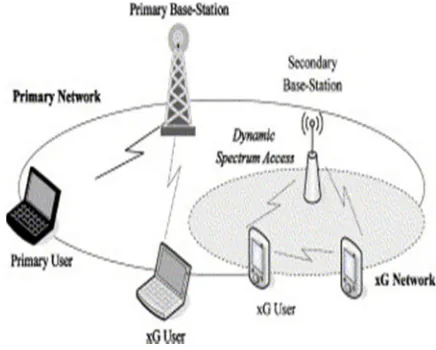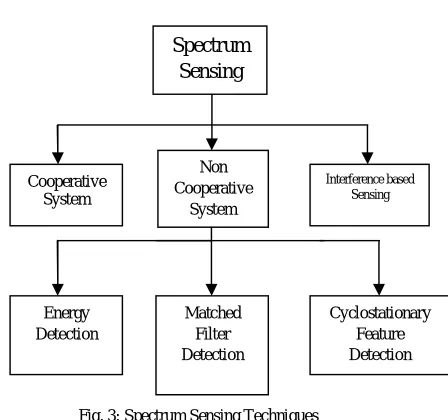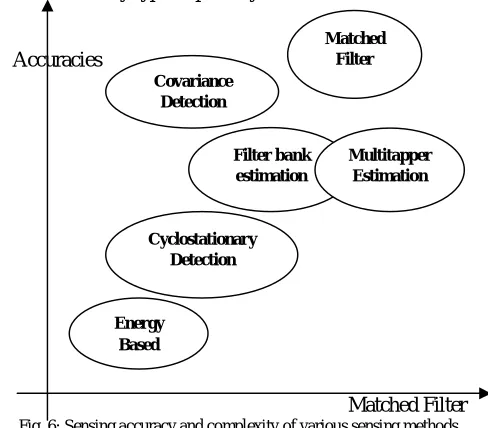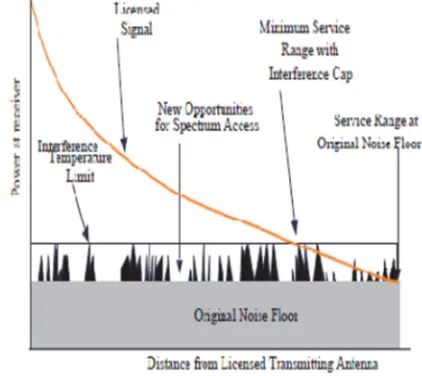ISSN: 2231-5381
http://www.ijettjournal.org
Page 695Spectrum Sensing Techniques and Issues in
Cognitive Radio
Bodepudi Mounika
# [1], Kolli Ravi Chandra
# [2], Rayala Ravi Kumar*
[3]#
B.Tech Final Year Student, Electronics & Communications Department, K L University
Vaddeswaram, Andhra Pradesh, India-522502
*
Assoc. Professor, Electronics & Communications Department, K L University
Vaddeswaram, Andhra Pradesh, India-522502
Abstract— In present day communication wireless communication has become the most popular communication. Because of this growing demand on wireless applications has put a lot of constraints on the available radio spectrum which is limited and precious. In fixed spectrum assignments there are many frequencies that are not being properly used. So cognitive radio helps us to use these unused frequency bands which are also called as “White Spaces”. This is a unique approach to improve utilization of radio electromagnetic spectrum. In establishing the cognitive radio there are 4 important methods. In this paper we are going to discuss about the first and most important method to implement cognitive radio i.e., “spectrum sensing”. The challenges, issues and techniques that are involved in spectrum sensing will discussed in detail.
Keywords— Primary User, Secondary User, Spectrum Sensing, Signal Processing Techniques.
I.INTRODUCTION
As the need of wireless communication applications are increasing the available Electromagnetic Spectrum band is getting crowded day by day. According to many researches it has been found that the allocated spectrum (licensed spectrum) is not utilized properly because of static allocation of spectrum. It has become most difficult to find vacant bands either to set up a new service or to enhance the existing one. In order to overcome these problems we are going for “Dynamic Spectrum Management” which improves the utilization of spectrum.
Cognitive Radio works on this dynamic Spectrum Management principle which solves the issue of spectrum underutilization in wireless communication in a better way. This radio provides a highly reliable communication. In this the unlicensed systems (Secondary users) are allowed to use the unused spectrum of the licensed users (Primary users). Cognitive radio will change its transmission parameters like wave form, protocol, operating frequency, networking etc
based on the interaction with environment in which it operates[2]. Figure 1 shows the Dynamic Spectrum Access in Cognitive Radio.
Fig. 1: Dynamic Spetrum Access
Cognitive radio has four major functions. They are Spectrum Sensing, Spectrum management, Spectrum Sharing and Spectrum Mobility. Spectrum Sensing is to identify the presence of licensed users and unused frequency bands i.e., white spaces in those licensed bands. Spectrum Management is to identify how long the secondary users can use those white spaces. Spectrum Sharing is to share the white spaces (spectrum hole) fairly among the secondary users. Spectrum Mobility is to maintain unbroken communication during the transition to better spectrum.
In terms of occupancy, sub bands of the radio spectrum may be categorized as follows:
ISSN: 2231-5381
http://www.ijettjournal.org
Page 696 B) Gray spaces: These are partially occupied by interferers aswell as noise.
C) Black spaces: The contents of which are completely full due to the combined presence of communication and (possibly) interfering signals plus noise [1].
Figure 2 shows the White Spaces and Used Frequencies in Licensed Spectrum.
Fig. 2: Illustration of White Spaces in Licensed Bands
When compared to all other techniques, Spectrum Sensing is the most crucial task for the establishment of cognitive radio based communication mechanism.
II. SPECTRUM SENSING
The major challenge of the cognitive radio is that the secondary user needs to detect the presence of primary user and to quickly quit the frequency band if the corresponding primary radio emerges in order to avoid interference to primary users.
Spectrum sensing technique can be categorized into two types. They are: Direct and Indirect Techniques. Direct Technique is also called as frequency domain out in which estimation is carried out directly from signal approach. Where as in Indirect Technique (also called as time domain approach), in this technique estimation is performed using autocorrelation of the signal. Another way of classification depends on the need of spectrum sensing as stated below.
A. Spectrum Sensing for Spectrum opportunities
1) Primary transmitter detection :Based on the received signal at CR users the detection of primary users is performed. This approach includes matched filter (MF) based detection, energy based detection, covariance based detection, waveform based detection, cyclostationary based detection, Primary Transmitter Detection etc [9].
2) Cooperative and collaborative detection: The primary
signals for spectrum opportunities are detected reliably by interacting or cooperating with other users, and the method can be implemented as either centralized access to spectrum coordinated by a spectrum server or distributed approach implied by the spectrum load smoothing algorithm or external detection.
B. Spectrum Sensing for Interference Detection
1) Interference temperature detection: In this approach, CR system works as in the ultra wide band (UWB) technology where the secondary users coexist with primary users and are allowed to transmit with low power and are restricted by the interference temperature level so as not to cause harmful interference to primary users.
2) Primary receiver detection: In this method, the
interference and/or spectrum opportunities are detected based on primary receiver's local oscillator leakage power [8].
III. CLASSIFICATION OF SPECTRUM SENSING TECHNIQUES
Fig. 3: Spectrum Sensing Techniques
A. Primary Transmitter Detection: In this we are going to discuss about few primary transmitter detection techniques. They are:
1) Energy Detection: In this technique there is no need of prior knowledge of Primary signal energy.
Fig. 4: Block Diagram of Energy Detection
Spectrum Sensing
Cooperative System
Non Cooperative
System
Interference based Sensing
Energy Detection
Matched Filter Detection
Cyclostationary Feature Detection
BPF Integrator
H0
H1
ISSN: 2231-5381
http://www.ijettjournal.org
Page 697 Where H0 = Absence of User.H1 = Presence of User.
The block diagram for the energy detection technique is shown in the Figure 4. In this method, signal is passed through band pass filter of the bandwidth W and is integrated over time interval. The output from the integrator block is then compared to a predefined threshold. This comparison is used to discover the existence of absence of the primary user. The threshold value can set to be fixed or variable based on the channel conditions [5]-[7].
y(k) = n(k)……… H0 y(k) = h * s(k) + n(k)…… H1
Where y (k) is the sample to be analyzed at each instant k
and n (k) is the noise of variance σ2. Let y(k) be a sequence of
received samples kϵ{1, 2….N} at the signal detector, then a decision rule can be stated as,
H0…… if ɛ > v H1…… if ɛ < v
Where ɛ = E |y(k)|2 the estimated energy of the received
signal and v is chosen to be the noise variance σ2.
However ED is always accompanied by a number of disadvantages i) Sensing time taken to achieve a given probability of detection may be high. ii) Detection performance is subject to the uncertainty of noise power. iii) ED cannot be used to detect spread spectrum signals.
2) Matched Filter: T
Fig. 5: Block Diagram of Matched Filter
Where H0 = Absence of User.
H1 = Presence of User.
A matched filter (MF) is a linear filter designed to maximize the output signal to noise ratio for a given input signal. When secondary user has a priori knowledge of primary user signal, matched filter detection is applied. Matched filter operation is equivalent to correlation in which the unknown signal is convolved with the filter whose impulse response is the mirror and time shifted version of a reference signal. The operation of matched filter detection is expressed as:
Y[n] = Σ h[n-k] x[k]
Where ‘x’ is the unknown signal (vector) and is convolved with the ‘h’, the impulse response of matched filter that is matched to the reference signal for maximizing the SNR. Detection by using matched filter is useful only in cases where
the information from the primary users is known to the cognitive users [9].
Advantages: Matched filter detection needs less detection time because it requires only O (1/SNR) samples to meet a given probability of detection constraint. When the information of the primary user signal is known to the cognitive radio user, matched filter detection is optimal detection in stationary Gaussian noise.
Disadvantages: Matched filter detection requires a prior knowledge of every primary signal. If the information is not accurate, MF performs poorly. Also the most significant disadvantage of MF is that a CR would need a dedicated receiver for every type of primary user.
Accuracies
Matched Filter
Fig. 6: Sensing accuracy and complexity of various sensing methods
B. Cooperative Techniques
1) Decentralized Uncoordinated Techniques: In
uncoordinated techniques Cognitive Radio will independently detects the channel and will vacate the channel when it finds a primary user without informing the other users. So Cognitive Radio users will experience bad channel realizations detect the channel incorrectly thereby causing interference at the primary receiver. So these are not advantageous when compared to coordinated techniques.
2) Centralized Coordinated Techniques: Here in this
technique we have Cognitive Radio controller. When one Cognitive Radio detects the presence of primary user then it intimates the Cognitive Radio controller about it. Then that controller informs all the Cognitive radio users by broadcast method. This is further more classified into two types as partially cooperative in which network nodes cooperate only in sensing the channel. The other technique is totally cooperative in which nodes cooperate in relaying each other’s information in addition to cooperatively sensing the channel
[4]
.
BPF Matched Filter
H0
H1
Energy Based
Cyclostationary Detection
Filter bank estimation
Multitapper Estimation Covariance
Detection
ISSN: 2231-5381
http://www.ijettjournal.org
Page 6983) Decentralized Coordinated Techniques: This type of
coordination implies building up a network of cognitive radios without having the need of a controller. Various algorithms have been proposed for the decentralized techniques among which are the gossiping algorithms or clustering schemes, where cognitive users gather to clusters, auto coordinating themselves. The cooperative spectrum sensing raises the need for a control channel, which can be implemented as a dedicated frequency channel or as an underlay UWB channel.
4) Advantages of Cooperation: Cognitive users selflessly cooperating to sense the channel have lot of benefits among which the plummeting sensitivity requirements: channel impairments like multipath fading, shadowing and building penetration losses, impose high sensitivity requirements inherently limited by cost and power requirements.
5) Disadvantages: Cooperative technique even has
disadvantage like the CR users need to perform sensing at periodic time intervals as sensed information become fast due to factors like mobility, channel impairments etc.
Fig. 7: a-Centralized Coordinated, b-Decentralized Coordinated, and c-Decentralized Uncoordinated.
B. Interference Based Detection: In this section, we present interference based detection so that the CR users would operate in spectrum underlay (UWB like) approach.
1) Primary Receiver Detection: Primary receiver emits the local oscillator (LO) leakage power from its RF front end while receiving the data from primary transmitter. It has been suggested as a method to detect primary user by mounting a low cost sensor node close to a primary user's receiver in order to detect the local oscillator (LO) leakage power emitted by the RF front end of the primary user's receiver which are within the communication range of CR system users. The local sensor then reports the sensed information to the CR users so that they can identify the spectrum occupancy status. We note that this method can also be used to identify the spectrum opportunities to operate CR users in spectrum overlay.
2) Interference Temperature Management: Unlike the primary
receiver detection, the basic idea behind the interference temperature management is to set up an upper interference limit for given frequency band in specific geographic location
such that the CR users are not allowed to cause harmful interference while using the specific band in specific area. Typically, CR user transmitters control their interference by regulating their transmission power (their out of band emissions) based on their locations with \respect to primary users. This method basically concentrates on measuring interference at the receiver [6]. The operating principle of this method is like an UWB technology where the CR users are allowed to coexist and transmit simultaneously with primary users using low transmit power that is restricted by the interference temperature level so as not to cause harmful interference to primary users.
Fig. 8: Inference Temperature Model
IV. ISSUES IN SPECTRUM SENSING
A. Channel Uncertainty: Because of fading or shading of the channel there will be uncertainties in the received signal strength which will lead to wrong interpretation. To avoid this Cognitive Radios must have high sensitivity so that he can differentiate between faded primary signal and a white space. If the fading is severe, a single cognitive radio cannot give high sensitivity so handle this we go for a set of cognitive radios which share their local measurements and collectively decide on the occupancy state of a licensed band.
B. Noise Uncertainty: The detection sensitivity can be defined as the minimum SNR at which the primary signal can be accurately detected by the cognitive radio and is given by ɤmin=PpL(D+R)
N Where N= Noise power.
Pp= Power Transmitted by Primary User.
ISSN: 2231-5381
http://www.ijettjournal.org
Page 699 The noise power estimation is limited by calibration errorsas well as changes in thermal noise caused by temperature variations. Since a cognitive radio may not satisfy the sensitivity requirement due to underestimate of N, ɤmin should
be calculated with the worst case noise assumption, thereby necessitating more sensitive detector [10].
C. Aggregate Interference Uncertainty: If multiple Cognitive Radios are operating same in same licensed band which will lead to spectrum sensing will be affected by uncertainty in aggregate interference. Even though the primary user is out of interference range this uncertainty may lead to wrong detection so this uncertainty will create a need of more sensitive detector.
D. Sensing Interference Limit: There are two factors for this issue that is when an unlicensed user may not know exactly the location of the licensed receiver which is required to compute interference caused due to its transmission and the second reason is that if a licensed receiver is a passive device, the transmitter may not be aware of the receiver. So these factors need attention while calculating the sensing interference limit.
V. CONCLUSION
As the usage of frequency spectrum is increasing, it is becoming more valuable. So we need to access the frequency spectrum wisely. For this purpose we are using Cognitive Radio. In our paper we discussed about the most important technique that is Spectrum sensing and the issues involved in it to establish the communication using Cognitive radio. We also said about important the importance of cooperation between Secondary users to avoid interference.
ACKNOWLEDGMENT
I wish to convey warmest thanks to my supervisor Mr. Rayala Ravi Kumar, Department of Electronic and Communication Engineering at Koneru Lakshmaiah University for his support and encouragement. I also would like to thank all staff and my friends at Koneru Lakshmaiah University for their kind help.
REFERENCES
[1] S. Haykin, Cognitive Dynamic Systems, Proceedings of the IEEE, vol. 94, no. 11, Nov. 2006, pp. 1910-1911
[2] B. A. Fette (Editor), Cognitive Radio Technology, Elsevier 2006, Hardcover, 656 Pages, ISBN 978-0-7506-7952-7
[3] D. B. Rawat, G. Yan, C. Bajracharya (2010), “Signal Processing Techniques for Spectrum Sensing in Cognitive Radio Networks’’, International Journal of Ultra Wideband Communications and Systems, Vol. x, No. x/x, pp:1-10
[4] M. Di Renzo, L. Imbriglio, F. Graziosi, F. Santucci, (2009), “Distributed data fusion over correlated log- normal
sensing and reporting channels: application to cognitive radio networks”,IEEE Transactions on Wireless Communications pp: 5813-5821
[5] E. Hossain, V. K. Bhargava (Editors), Cognitive Wireless Communication Networks, Springer 2007, approx. 450 pages, ISBN 978-0-387-68830-5
[6] F. Zeng, Z. Tian, C. Li (2010), “Distributed compressive wideband spectrum sensing in cooperative multi- hop cognitive networks”, in: Proc. Of IEEE ICC 2010, pp: 1-5. [7] D. Cabric, A. Tkachenko, and R. Brodersen, (2006) “Spectrum sensing measurements of pilot, energy and collaborative detection,” in Proc. IEEE Military Commun. Conf., Washington, D.C., USA, pp: 1-7.
[8] Takeshi Ikuma and Mort Naraghi-Pour (2008), “A Comparison of Three Classes of Spectrum Sensing Techniques”, IEEE GLOBECOM proceedings.
[9] Ian F. Akyildiz, Brandon F. Lo, Ravikumar (2011), “Cooperative spectrum sensing in cognitive radio networks: A survey, Physical Communication”, pp: 40-62.



